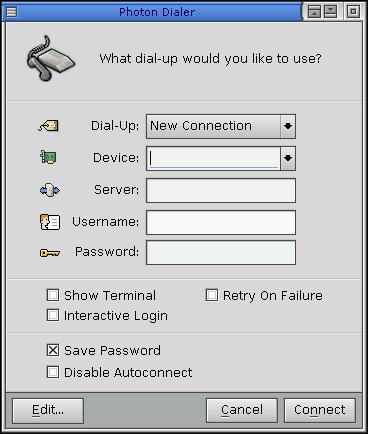![[Previous]](../prev.gif) |
![[Contents]](../contents.gif) |
![[Index]](../keyword_index.gif) |
![[Next]](../next.gif) |
![[Previous]](../prev.gif) |
![[Contents]](../contents.gif) |
![[Index]](../keyword_index.gif) |
![[Next]](../next.gif) |
Modem dialer
phdialer options
| If server_name is: | This server is used: |
|---|---|
| node_path | node_path/dev/photon |
| fullpath | fullpath |
| relative_path | /dev/relative_path |
The phdialer command starts Photon's modem dialer (for example, so you can access your ISP):

The phdialer is meant to be simple and small. You can change only the bare minimum of dialup settings in its base window -- just enough so you get a dialup started. If data has been entered it and the Save changes box is checked, phdialer asks you for a name to save the dialup as. If you cancel, the changes are lost. All dialups in your dialup directory are listed in the combobox at the top.
The phlip, command gives you access to all information about a dialup. When you click on Edit in phdialer, it spawns phlip and makes the dialup that was current come up.
In addition to the system device and network settings, phlip has a dialup tab that lists the user's dialup configurations. There's one panel and one configuration file per dialup. These usually reside in the ${HOME}.ph/dialups directory. You can copy these files from one user's dialup directory to another, but the password isn't be preserved and the new user must enter it again (even root).
If you're not root when you run phlip, the network and device panels contain read-only information. You can make changes only to your dialups.
![[Previous]](../prev.gif) |
![[Contents]](../contents.gif) |
![[Index]](../keyword_index.gif) |
![[Next]](../next.gif) |